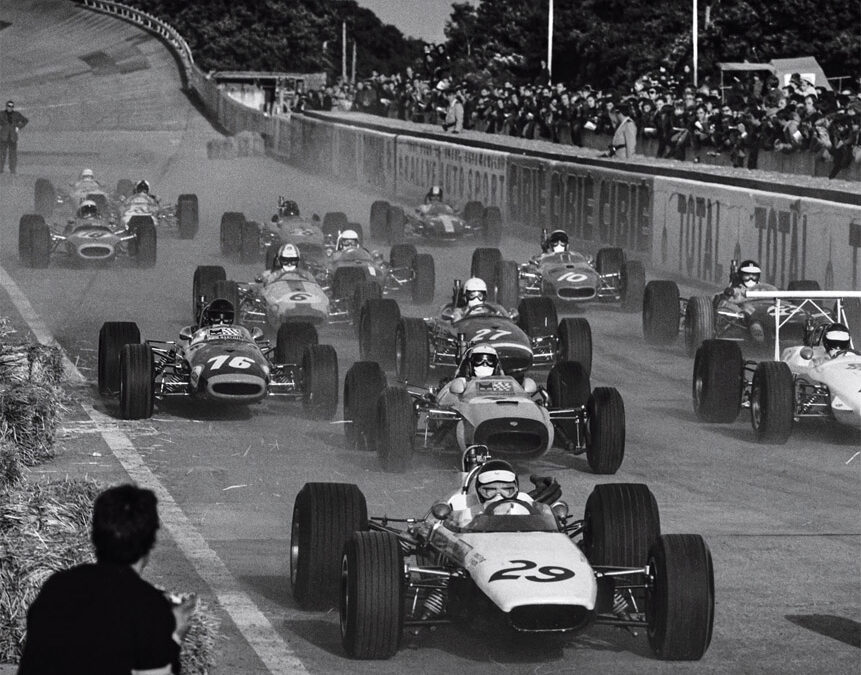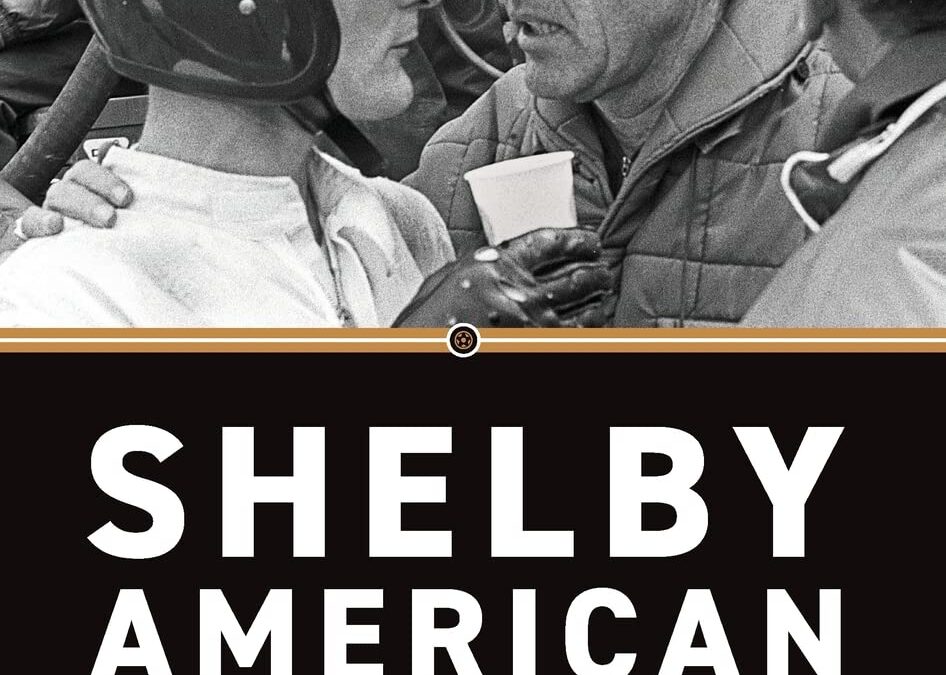
Shelby American didn’t last long, but it was a flame that burned incandescently before being extinguished by corporate politics. In less than a decade, it created a legacy that will be revered as long as cars still roar around racetracks. Now, on the sixtieth anniversary of the founding of this iconic company, Shelby American: The Renegades Who Built the Cars, Won the Races, and Lived the Legend relates how the saga unfolded, as told by the men and women who were there at the time.
Although Carroll Shelby was the focal point of the publicity his company generated, Shelby American was staffed by a who’s who of racing legends, from Phil Remington and Ken Miles to Peter Brock and Carroll Smith. And while the shop is often depicted as a menagerie of Southern California hot rodders, it also embraced mechanics and fabricators from Canada, England, Switzerland, Australia, and New Zealand. Like the Cobra itself, the company magically came together as a whole that was greater than its constituent parts.
By incorporating the recollections of dozens of lesser-known crewmen, Shelby American goes behind the scenes to tell long untold and misunderstood stories―the cheat embedded in the turbine Indy car, the oiling woes that sunk the tunnel-port Trans-Am Mustang, even details about the build of the first Cobra in Dean Moon’s cramped garage in Santa Fe Springs. The book also delves into the personalities and hijinks that made Shelby American such a vibrant place to work, whether they were transforming humdrum Mustangs into race-ready GT350 or fighting shop wars with cherry bombs and M-80s.
Always standing above it all was Shelby himself. Dynamic, charismatic, mercurial, mercenary, and a little bit dangerous, he had to fight Ford bean counters as fiercely as he dueled with Enzo Ferrari. But for a few magical years, Shelby managed to beat both of them at their own games.
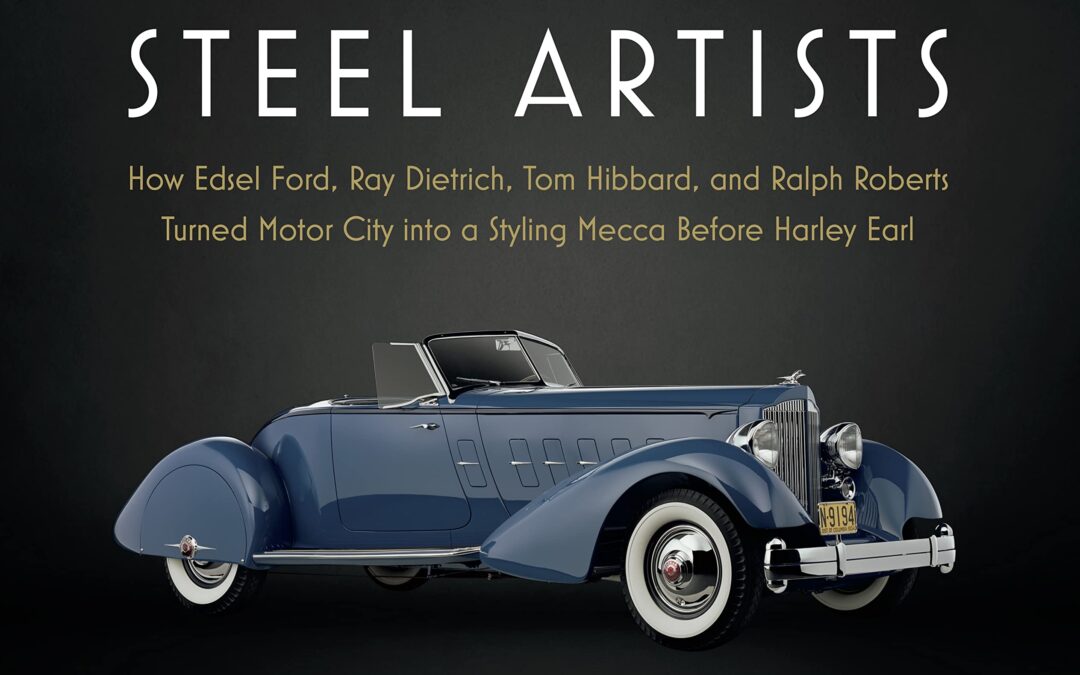
A groundbreaking book on how automotive styling was born, the artists who made it happen, and how Motor City was changed forever.
Printed in a large 12″ x 12″ format with 296 hardbound pages, Detroit Steel Artists is the first comprehensive story about the avant-garde artists of the automotive business—the industries’ outcasts who changed Motor City forever and made styling an important selling point in the early 1920s.
Styling is a given today for selling cars. How did that come to be? Societal changes, including the modernization of business and the women’s movement, were powerful factors for styling’s rise in significance. The forward-looking semi-custom car designs, from companies such as Le Baron and Dietrich, became a key strategy for styling’s acceptance in Detroit for production cars—before Harley Earl.
Inspired by Edsel Ford’s vision, Ray Dietrich, Tom Hibbard, and Ralph Roberts battled with engineers and executives in drafting rooms and board rooms over design. Packed with lively first-person stories supported by extensive research, Detroit Steel Artists relates the successes and failures of these fascinating pioneering steel artists. With more than a hundred period and modern images, Detroit Steel Artists takes readers on a panoramic tour of some of the most beautiful cars of the Classic Car Era—the zenith of automotive design.
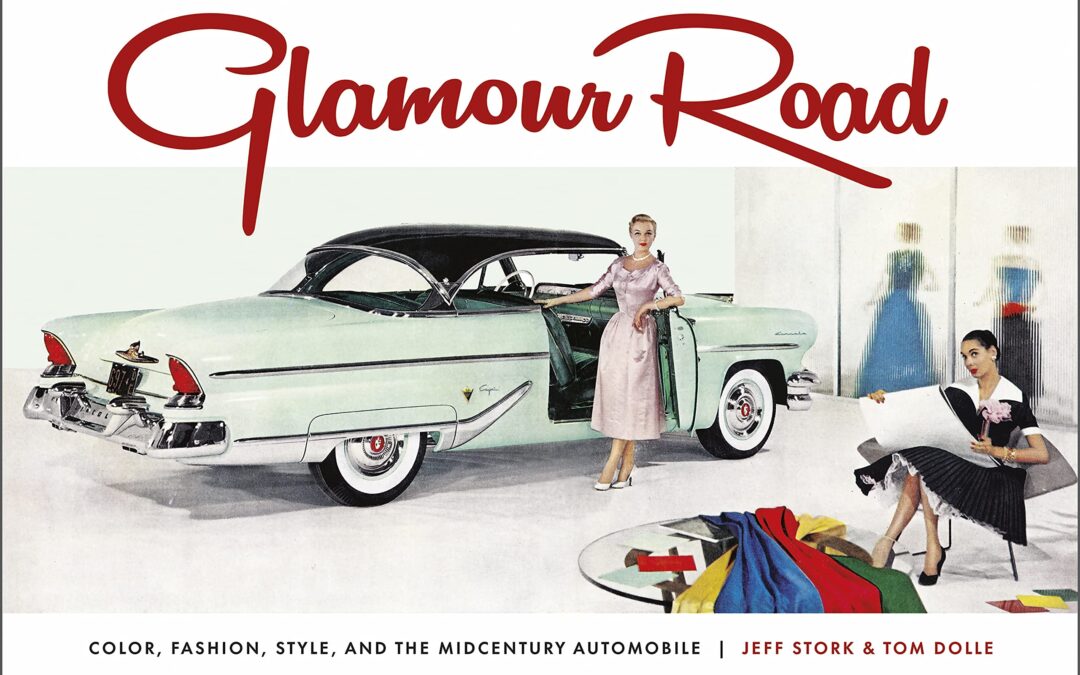
SOLD OUT AWAITING PUBLISHER RE-PRINT
This highly visual book explores the seldom-told story of how glamour, fashion, design, and styling became the main focus of automotive marketing from the postwar 1940s through the 1970s. With the expansion of the American suburbs after WWII, women suddenly needed cars of their own. By adopting the fashion industry’s yearly model changes, as well as hiring many designers and stylists from the fashion industry, the automobile industry made a direct appeal to the rising sophistication and influence of women. By perfecting the fashion-centric concept of planned obsolescence, it became the dominant economic engine of American postwar prosperity. The dramatic photography, elegant fashion, and use of color and materials in midcentury automotive marketing created a groundswell of demand for new cars. Much of the marketing imagery of the period hasn’t been published since it first came out, and this book features some of the best.

The inspiring, heart-pumping true story of soldiers turned cyclists and the historic 1919 Tour de France that helped to restore a war-torn country and its people.
On June 29, 1919, one day after the Treaty of Versailles brought about the end of World War I, nearly seventy cyclists embarked on the thirteenth Tour de France. From Paris, the war-weary men rode down the western coast on a race that would trace the country’s border, through seaside towns and mountains to the ghostly western front. Traversing a cratered postwar landscape, the cyclists faced near-impossible odds and the psychological scars of war. Most of the athletes had arrived straight from the front, where so many fellow countrymen had suffered or died. The cyclists’ perseverance and tolerance for pain would be tested in a grueling, monthlong competition.
An inspiring true story of human endurance, Sprinting Through No Man’s Land explores how the cyclists united a country that had been torn apart by unprecedented desolation and tragedy. It shows how devastated countrymen and women can come together to celebrate the adventure of a lifetime and discover renewed fortitude, purpose, and national identity in the streets of their towns.

Meet drag racing legend and pioneer Shirley Shahan, the Drag-On Lady!
As the first woman to win an NHRA national event when she was named Top Stock Eliminator at the 1966 Winternationals, Shahan blazed a trail for women in drag racing. During the golden era of drag racing, it was rare to find diversity in the sport. Shahan is what’s commonly known as a living legend.
In a career that spanned the 1950s and into the early 1970s, Shahan drove 1956 and 1958 Chevys and was one of the lucky few who was able to purchase one of the rare 1963 Chevrolet RPO Z11 Super Stockers. Later, when she was driving for Plymouth and Dodge, Shahan made the name Drag-On Lady both famous and feared. She then moved to American Motors and raced very successfully with the new SS/AMX.
From 1958 to 1972, Shahan set records and won numerous awards. She was inducted into the International Drag Racing Hall of Fame, Super Stock Magazine Hall of Fame, and Mopar Hall of Fame, and she was honored with a lifetime achievement award at the Bakersfield racetrack. In addition, Shirley won the Top Stock category at the very first March Meet at the legendary the Famoso Raceway track near Bakersfield, California, which made her the first person (male or female) to do so. In 1966, she was the named one of Hot Rod magazine’s Top 10 Drivers.
She raced against the best drivers during the golden age of drag racing and more often than not blew off the doors of her opponents. She had a fierce passion for winning, and in this book, you’ll feel what it was like to be behind the wheel as she steers you through her illustrious career. Fasten your seat belt; it’s going to be a wild ride.

Freewaytopia: How Freeways Shaped Los Angeles explores how social, economic, political, and cultural demands created the web of freeways whose very form―futuristic, majestic, and progressive―perfectly exemplifies the City of Angels.
From the Arroyo Seco Parkway, which began construction during the Great Depression, to the Century Freeway, completed in 1993, author Paul Haddad provides an entertaining and thought-provoking history of the 527 miles of roadways that comprise the Los Angeles freeway system.
Each of Los Angeles’s twelve freeways receives its own chapter, and these are supplemented by “Off-Ramps”―sidebars that dish out pithy factoids about Botts’ Dots, SigAlerts, and all matter of freeway lexicon, such as why Southern Californians are the only people in the country who place the word “the” in front of their interstates, as in “the 5,” or “the 101.”
Freewaytopia also explores those routes that never saw the light of day. Imagine superhighways burrowing through Laurel Canyon, tunneling under the Hollywood Sign, or spanning the waters of Santa Monica Bay. With a few more legislative strokes of the pen, you wouldn’t have to imagine them―they’d already exist.
Haddad notably gives voice to those individuals whose lives were inextricably connected―for better or worse―to the city’s freeways: The hundreds of thousands of mostly minority and low-income residents who protested against their displacement as a result of eminent domain. Women engineers who excelled in a man’s field. Elected officials who helped further freeways . . . or stop them dead in their tracks. He pays tribute to the corps of civic and state highway employees whose collective vision, expertise, and dedication created not just the most famous freeway network in the world, but feats of engineering that, at their best, achieve architectural poetry. And let’s not forget the beauty queens―no freeway in Los Angeles ever opened without their royal presence.
Freewaytopia is part colorful lore, part civic and historical critique, and part homage to the most famous freeways in the world.
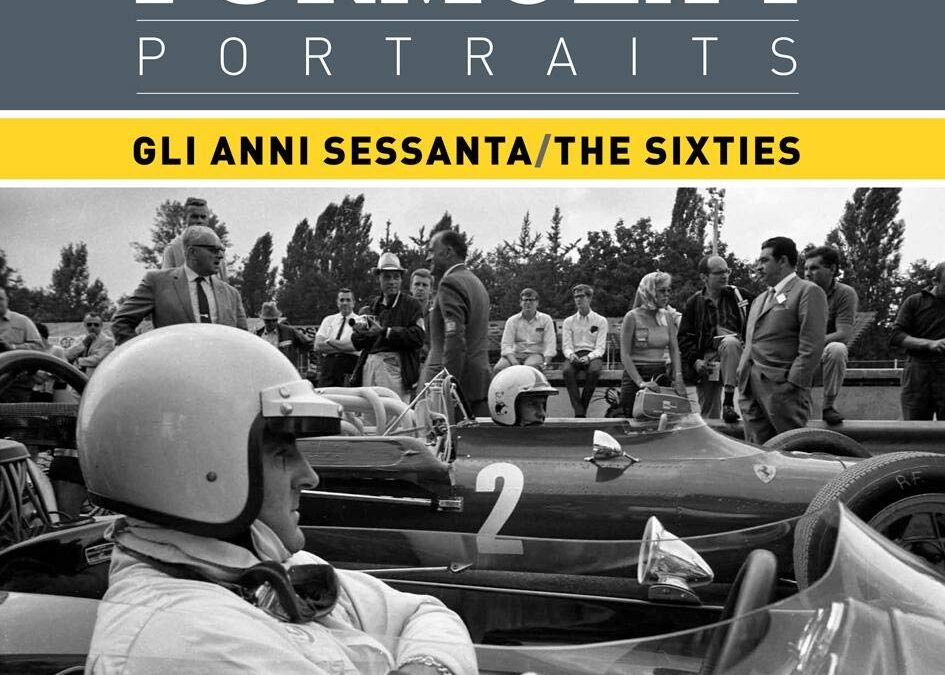
A collection of characters, drivers, champions and mechanics who animated Formula 1’s glorious sixties.
In this unique book, the first of a series that decade by decade will review the history of motorsport’s ultimate championship through to the 2000s, it is above all the portraits that speak, giving a face to men who have truly written the history of the blue ribbon series, all thanks to an incomparable repertoire of previously unpublished photos accompanied by texts by Gianni Cancellierii, one of the leading motorsport experts. 7 February 1960, Bruce McLaren wins the GP of Argentina at the wheel of a rear-engined Cooper that the year before had carried Jack Brabham to the World Championship title. This was the first great novelty of the decade: in order to be successful the cars had to have their engine behind the cockpit. Then, in 1961, came the 1.5-litre engines and even Ferrari followed the rear-engine trend. This was an epochal revolution. A decade was underway that would see great feats, great victories and great tragedies and of course great drivers of the calibre of Phil Hill, Jack Brabham, Jim Clark, John Surtees, Graham Hill, Denny Hulme, Jackie Stewart and many others. However, in this “gallery of faces” there are also designers, team managers, mechanics, women in the pits as well as the ever-varied world of the tifosi. Formula 1 Portraits is all this and more, an overview of motorsport’s most important category, the book that should be on the shelves of every F1 connoisseur as well those of all the young neophytes approaching this enthralling world for the first time.
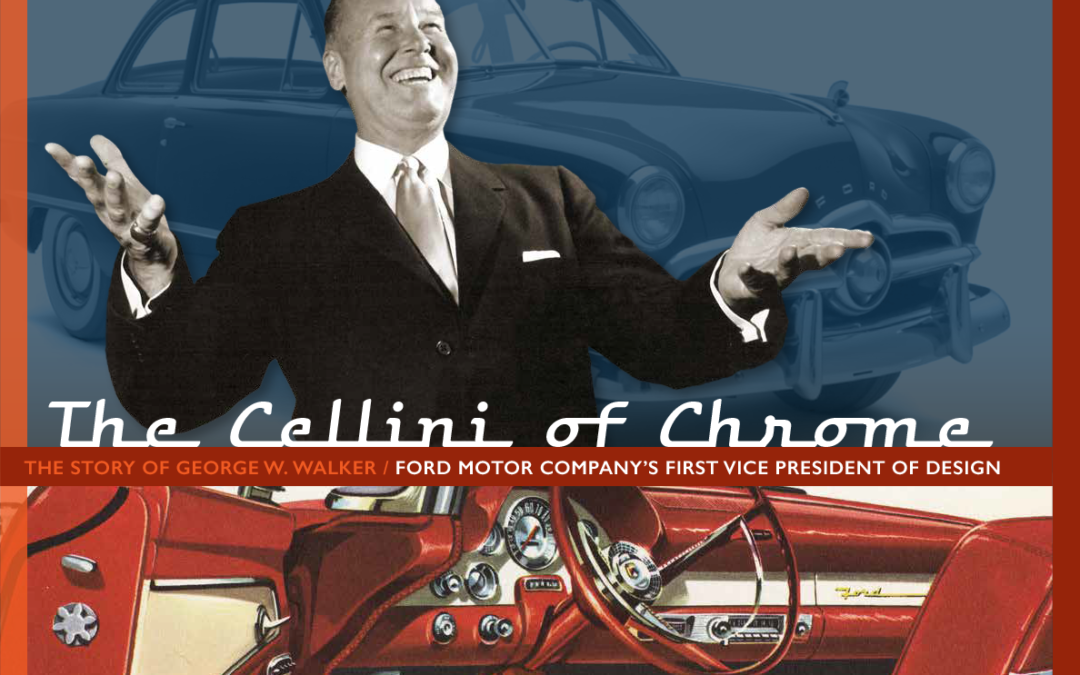
Henry Dominguez’s newest book The Cellini of Chrome, introduces the surprisingly unknown but truly fascinating career of George Walker, the Ford Company’s first full Vice President of Styling.
In the same flamboyant vein as other design greats such as Harley Earl, Gordon Buerig, Vergil Exner, Raymond Loewy and William “Bill” Mitchell, Walker developed the standard for key Ford Motor Company Products for the 1950s and ‘60’s. Beginning with the enormous success of the 1949 Ford, George became the catalyst for the iconic appearance of Ford, Mercury and Lincoln models, elevating Henry’s company to one of the all-around best-selling Automotive operations in the World.
With a personal history anything but bland, his elegant style of dress, appeal to attractive women, signature winning smile, and willingness go toe to toe with industry giants such as Henry Ford II (“The Deuce”) and other top executives, Walker made himself a key figure in the highly competitive environment of mid-20th Century automotive design.
His story is a must for any automotive enthusiast looking for an inside view of how the stylistic character of Ford products was created by Walker and his associates.

Auto Repair For Dummies, 2nd Edition (9781119543619) was previously published as Auto Repair For Dummies, 2nd Edition (9780764599026). While this version features a new Dummies cover and design, the content is the same as the prior release and should not be considered a new or updated product.
The top-selling auto repair guide–400,000 copies sold–now extensively reorganized and updated
Forty-eight percent of U.S. households perform at least some automobile maintenance on their own, with women now accounting for one third of this $34 billion automotive do-it-yourself market. For new or would-be do-it-yourself mechanics, this illustrated how-to guide has long been a must and now it’s even better. A complete reorganization now puts relevant repair and maintenance information directly after each automotive system overview, making it much easier to find hands-on fix-it instructions. Author Deanna Sclar has updated systems and repair information throughout, eliminating discussions of carburetors and adding coverage of hybrid and alternative fuel vehicles. She’s also revised schedules for tune-ups and oil changes, included driving tips that can save on maintenance and repair costs, and added new advice on troubleshooting problems and determining when to call in a professional mechanic. For anyone who wants to save money on car repairs and maintenance, this book is the place to start.
Deanna Sclar (Long Beach, CA), an acclaimed auto repair expert and consumer advocate, has contributed to the Los Angeles Times and has been interviewed on the Today show, NBC Nightly News, and other television programs.
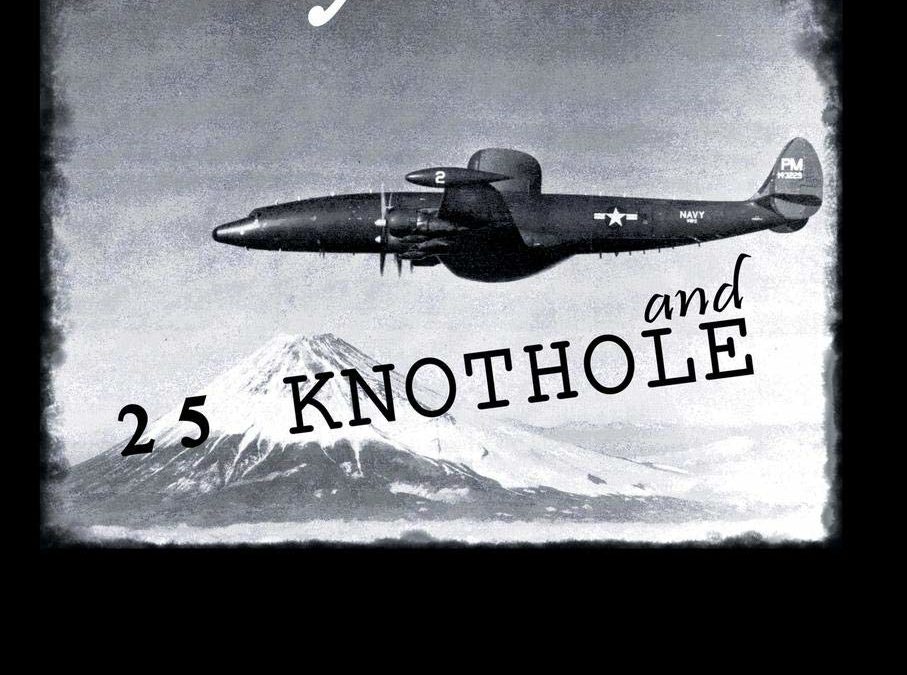
In the early hours of April 17, 1952 World War III nearly began. The Distant Early Warning line (DEW) was still an idea to be addressed by the U.S. government and its top military brass. “Willy Victor and 25 knothole” is about that vital cog of airborne defense against the real threat of a sneak attack (atomic and/ or airborne) against the American mainland. Bruce Jarvis, former naval flight crew member, recounts the operations of his Airborne Early Warning Squadron (AEWRON) experience, flying in a Lockheed Super Constellation Warning Star ( Navy designation Willy Victor-2) in support of the DEW line that became fully operable in the year 1957. It introduces readers to the flyers’ lives during the Cold War, and with little fanfare (but much moxie) recalls the unknown heroism of some of the front line troops in the form of a fictional but typical crew of naval airmen, of the now defunct conflict between Russia and the United States. Although the crew is fictional, their stories are true.
The entire U.S. air defense effort was conceptualized by what is known as the Lincoln Summer Study Group in 1952. It was in response to the panic in NORAD ( the North American Defense Command ) when “bogeys” or aircraft contrails were spotted near northern Canada-the U.S. had neither warning nor the means to combat its threat, if any. Had Kruschechev so chosen, the bogeys could have been the vanguard of a Russian first strike on the heart of America. The stories in “Willy Victor and 25 knothole” include purposes of the AEWRON missions, their importance, the people who flew them, personal anecdotes, their ground crews, their families and women and their sad or happy moments. It shows the human face of a war mostly fought in the rarefied scientific/technological and secret ops realms. Bruce Jarvis has taken good care in writing this book so that Americans may know and not forget the few good men who put their lives on the line during the cold war to protect the United States of America.
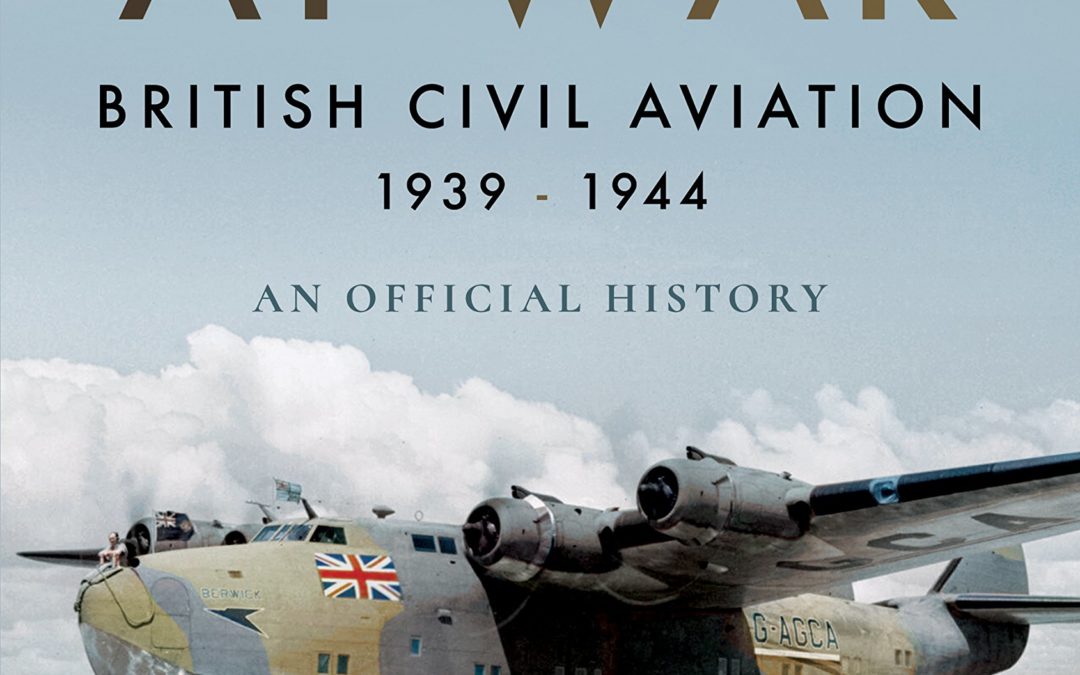
The brave efforts of the pilots and crew of the RAF during the Second World War are well-known but there was another body of aviators that played a significant role in the conflict – the men and women of the civilian airlines.
The British Overseas Airways Corporation (BOAC) was formed shortly after the outbreak of war in November 1939 by the amalgamation of Imperial Airways and British Airways. During the war BOAC operated as directed by the Secretary of State for Air, initially as the transport service for the RAF and with no requirement to act commercially. The inaugural BOAC had eighty-two aircraft, a large proportion of which were seaplanes and flying boats. With 54,000 miles of air routes over many parts of the world, ranging from the Arctic to South Africa, from the Atlantic coast of America to the eastern coast of India, the aircraft of the BOAC kept wartime Britain connected with its colonies and the free world, often under enemy fire. Over these routes, carrying mail, cargo and personnel, the men and machines of BOAC flew in the region of 19,000,000 miles a year.
There can rarely have been a moment, throughout the war, when aircraft of the British merchant air service were not flying somewhere along the routes, despite losses from enemy action. This book explores much of their war history between 1939 and 1944 (the year that marked the 25th anniversary of British commercial aviation), something of their lives and their achievements in linking up the battlefronts – at times cut off from any direct land or sea contacts with the Home Front – and in transporting supplies through the new, dangerous and often uncharted regions of the air. With the ‘Speedbird’ symbol or the Union Flag emblazoned on its aircraft the BOAC really did fly the flag for Britain throughout the wartime world.

When Arlington National Cemetery refused to accept my grandmother’s last request to be laid to rest there, I refused to let her legacy as a veteran die along with her.
My grandmother, Elaine Danforth Harmon, flew as a pilot with the Women Airforce Service Pilots (WASP) of World War II. Despite being part of the first group of women to fly for the United States Army, the WASP remained officially unrecognized as members of the military due to discriminatory thinking about gender on Capitol Hill and beyond. Women flying planes? Too progressive for the World War II era.
When I was young, I thought of my grandmother’s trips to accept awards, or to visit the White House, or to give lectures about her time in the service, as her hobby. I knew what she had done and I knew that in the 1970s they had lobbied Congress to get the veterans’ status they had been denied during the war. From that point on, my grandmother shared her story of service with the WASP during World War II with anyone who would listen.
But it was not until after she died that I fully understood why she had spent so many years talking about her service with the WASP. My grandmother’s last request was to be laid to rest at Arlington National Cemetery. Our family was surprised when the United States Army, which managed the cemetery, denied that the WASP, and therefore my grandmother, were eligible for placement in the cemetery.
The Army said ‘no’ to the wrong family.
I led our family’s campaign on behalf of my grandmother, and all the women of the WASP, across social media, traditional news outlets, and to Capitol Hill to fight for their equal recognition at one of the nation’s most well-known cemeteries. My grandmother’s final fight came after her final flight – but I was honored to follow in her footsteps to ensure her legacy would not be forgotten.

TV presenter and all-round car nut Ant Anstead takes the reader on a journey that mirrors the development of the motor car itself from a stuttering 20mph annoyance that scared everyone’s horses to 150mph pursuits with aerial support and sophisticated electronic tracking.
The British Police Force’s relationship with the car started by chasing after pioneer speeding motorists on bicycles. As speed restrictions eased in the early twentieth century and car ownership increased, the police embraced the car. Criminals were stealing cars to sell on or to use as getaway vehicles and the police needed to stay ahead, or at least only one step behind. The arms race for speed, which culminated in the police acquiring high-speed pursuit vehicles such as Subaru Impreza Turbos, had begun.
Since then the car has become essential to everyday life. Deep down everyone loves a police car. Countless enthusiasts collect models in different liveries and legendary police cars become part of the nation’s shared consciousness.
Ant Anstead spent the first six years of his working life as a cop. He was part of the armed response team, one of the force’s most elite units. In this fascinating new history of the British police car, Ant looks at the classic cars, from the Met’s Wolseleys to the Senator, the motorway patrol car officers loved most, via unusual and unexpected police vehicles such as the Arial Atom. It’s a must-read for car enthusiasts, social historians and anyone who loves a good car chase, Cops and Robbers is a rip-roaring celebration of the police car and the men and women who drive them.
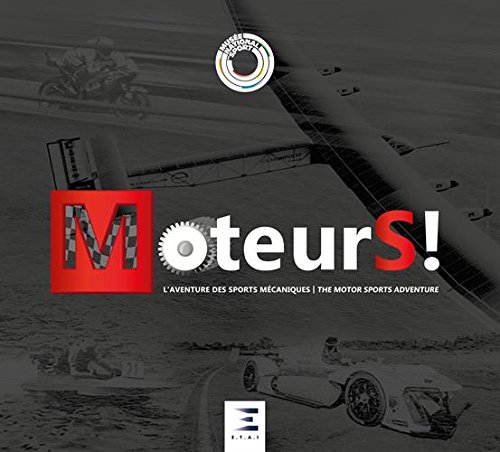
From the design of Icarus (the embodiment of the myth of flying) to the ecological considerations of the moving machines of the new millennium, to the advent of competition in the late nineteenth century, the sky, the sea and the land fascinate, challenge and question humanity. Under the lens of motor sports, human genius is unveiled in the quest for transcendence. Men and women with extraordinary journeys are the guides of this journey in the past and the present. Their ambition allowed to realize “the unthinkable”. For the first time in a company museum, airplanes, motorboats, automobiles and motorcycles are presented in an exhibition entitled EngineS! The National Museum of Sport is for a few months the crossroads of the most remarkable pieces of motorized vehicles, stories of pilots of legends, graphic representations of the drunkenness of speed … This catalog composed by the best specialists of the subject invites readers to a real journey in the world of motorsports and our dreams of the craziest machines …
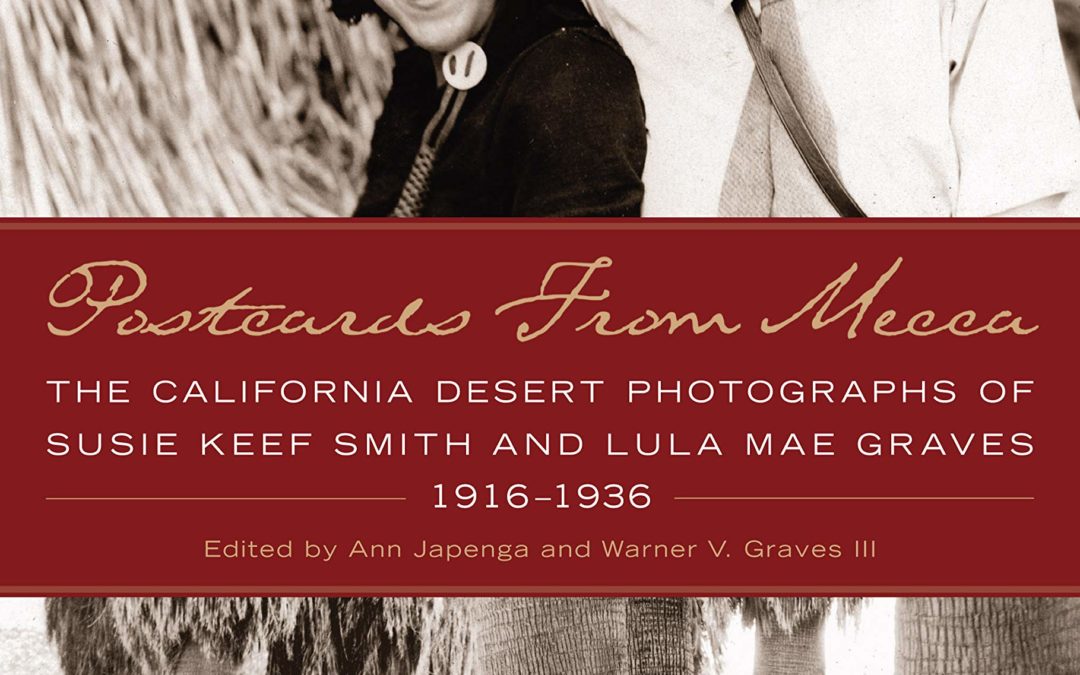
Susie Keef Smith was seeking escape from a troubled home life and the havoc of childhood polio when she took a job as postmaster in Mecca, on the edge of California’s Salton Sea. She and her cousin Lula Mae Graves set out to photograph the last of the prospectors, burro packers and stage stops in the remote desert to the east. They traveled by burro, foot and Ford though sandy washes and roadless canyons, armed with a .38 revolver and a large format camera. While making postcards for the Post Office spinner rack, the women were remade in the wilderness and wound up creating an unparalleled portrait of one of the lesser-known deserts in the West. Susie Smith’s photos were nearly lost to history when upon her death they were tossed out by a county estate administrator. A savvy archaeologist jumped into a dumpster and rescued many of the photos in this book. Postcards From Mecca presents portraits of a mysterious land along with the story of its heroic chroniclers, self-taught documentary photographers of the 1920s and ’30s.
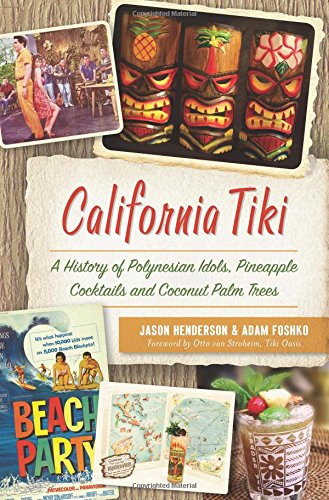
After World War II, suburbs proliferated around California cities as returning soldiers traded in their uniforms for business suits. After-hours leisure activities took on an island-themed sensuality that bloomed from a new fascination with Polynesia and Hawaii. Movies and television shows filmed in Malibu and Burbank urged viewers to escape everyday life with the likes of Gidget and Hawaiian Eye. Restaurants like Don the Beachcomber and Trader Vic’s sprang up to answer the demand for wild cocktails and even wilder décor. The culture–a strange hodgepodge of idols, torches, lush greenery and colorful drinks–beckoned men and women to lose themselves in exotic music and surf tunes. Authors Jason Henderson and Adam Foshko explore the state’s midcentury fascination with all things Tiki.

Gloria Tramontin Struck rode a motorcycle for the very first time at age 16 in 1941. Women simply didn’t ride motorcycles in 1941, but at the urging of her older brother, a very reluctant Gloria gave it a try, and it changed her life forever. She has been riding ever since, and at age 89, still rides regularly and continues to participate in cross country rides.
As you might expect, any woman regularly riding a motorcycle in an era when women didn’t ride motorcycles has a lot of stories to tell. In Gloria Struck: 75 years on Two Wheels and Still Riding, Gloria shares with you all of her favorite stories, from back when she was being raised behind her father’s motorcycle shop in Clifton NJ, through 75 years of riding tales, all the way to the present, where she is rightfully celebrated at motorcycles rallies and events. Complementing her life and riding stories is an extensive scrapbook of photos, over 100 of which are included in this autobiography. Also included are anecdotes provided by fans, friends and admirers.
Of course, Gloria’s book and her stories, are as much about overcoming prejudice and personal obstacles, as it is about riding motorcycles. Because of that, this book resonates with riders and non-riders alike. The message is about more than riding, it’s about meeting and conquering life’s challenges with courage and humor.
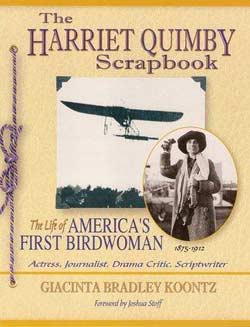
This first complete biography of Harriet Quimby is visually charming for all ages and a handy reference for entertainment, photography, travel, and aviation historians. With over 150 vintage newspaper clips and dozens of never before published photographs, it’s a must for every fan of early aviation.
Carrie Vanderbilt’s pictures of her best friend, Harriet Quimby, remained in storage for over 85 years. These photographs and dozens of other never-before published images are artfully presented with vintage newspaper clippings and Quimby family documents, as if Quimby had pasted them into her own scrapbook. Reprinted for the first time are Harriet Quimby’s seven silent film treatments for American Biograph.
Quimby was disarmingly unique. Ignoring criticism, and creating her own sense of style, she owned several cars, learned how to repair them, and encouraged other women to do the same. She smoked cigarettes, lived alone, and lied about her age. Cleverly calculating her professional career, she represented all that was independent and modern, yet she distanced herself from feminist causes.
Harriet Quimby’s life touched the fringes of the Civil War, the Industrial Revolution, the Ragtime Ear, and the new Age of Aviation. Moving from Michigan to California and finally to New York City during 1903, she was prepared to take it by storm. She had no alternate plan.
New York loved her. America admired her. The world was her oyster until tragedy struck. Before her death at age 37, her potential for continued fame, fortune, and contributions to U.S. history was limitless.
Scientific American eulogized that her death, ” while fitting for an athlete, should never have been the lot of such a fragile flower of sunny California.”.
This scrapbook represents more than the life of one woman. It is our cultural heritage.

Fasten your seat belts! Indy 500 driver Lyn St. James provides inspirational advice for everyone as she recounts her inspiring career as a world-renowned Indy driver. Lyn St. James was 45 years old when she joined the world of Indy racing. Now known as the American Woman Racing Icon of the Century, Lyn is a testament to the power of determination and positive thinking. In this inspiring, motivational book, St. James chronicles her last Indy 500 and looks back on a career filled with challenges. She recounts years of adversity and the struggle to obtain corporate sponsorships, despite being named the Indy 500 Rookie of the Year. She recalls record-breaking runs at Talladega and Daytona, terrifying crashes, and the joys of mentoring young women drivers. On every page of this story people will find the motivation and encouragement to follow their dreams and reach their goals.








